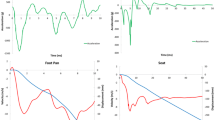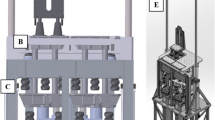Abstract
Military vehicle underbody blast (UBB) is the cause of many serious injuries in theatre today; however, the effects of these chaotic events on the human body are not well understood. The purpose of this research was to replicate UBB loading conditions on the human pelvis and investigate the resulting response in a controlled laboratory setting. In addition to better understanding the response of the human pelvis to high rate vertical loading, this test series also aimed to identify high rate injury thresholds. Twenty-seven post mortem human surrogate (PMHS) component pelvis tests were completed using the University of Virginia’s (UVa) simulated blast rig under a range of loading conditions and postures. Of those tests, 17 were in the anteriorly-tilted posture and used to construct the human injury probability curve. Average seat pan (rigid) accelerations for this subset of tests ranged from 300 to 2400 g over 2 to 3 ms of positive phase duration. Post-test computed tomography (CT) scans and necropsies were performed to determine injuries and revealed a frequent occurrence of anterior and posterior injuries, resulting in unstable pelvis ring fractures. The resulting Human Injury Probability Curve (HIPC) yielded mean forces of 5529, 8516, and 12431 N as measured by mass compensated seat platen loadcells applied through the rigid seat to the bilateral ischium are associated with a 10, 25, and 50% risk for unstable pelvic ring sacrum fractures in an anteriorly-tilted pelvis (28° from vertical), respectively.








Similar content being viewed by others
References
Akaike, H. A new look at the statistical model identification. IEEE Trans. Autom. Control 19(6):716–723, 1974.
Bailey, A. M., J. J. Christopher, F. Brozoski, and R. S. Salzar. Post mortem human surrogate injury response of the pelvis and lower extremities to simulated underbody blast. Ann. Biomed. Eng. 43(8):1907–1917, 2014.
Bailey, A., J. Christopher, K. Henderson, F. Brozoski, and R. S. Salzar. Comparison of Hybrid-III and PMHS Response to Simulated Underbody Blast Loading Conditions. Proceedings of IRCOBI Conference, pp. 158–171, 2013.
Bailey, A. M., B. J. Perry, and R. S. Salzar. Response and injury of the human leg for axial impact durations applicable to automotive intrusion and underbody blast environments. Int. J. Crashworthiness 22(5):479–487, 2017.
Bir, C., A. Barbir, F. Dosquet, M. Wilhelm, M. van der Horst, and G. Wolfe. Validation of lower limb surrogates as injury assessment tools in floor impacts due to anti-vehicular land mines. Mil. Med. 173(12):1180–1184, 2008.
Bouquet, R., M. Ramet, F. Bermond, Y. Caire, Y. Talantikite, S., Robin, and E. Voiglio. Pelvis Human Response to Lateral Impact. Proceedings of the 16th International Technical Conference on the Enhanced Safety of Vehicles, Windsor, ON, Canada, pp. 1665–1686, 1998.
Bouquet, R., M. Ramet, F. Bermond, and D. Cesari. Thoracic and pelvis human response to impact. In: Proceedings of 14th ESV, pp. 100–109, 1994.
Brier, G. W. Verification of forecasts expressed in terms of probability. Mon Wea Rev. 78(1):1–3, 1950.
Cesari, D., and M. Ramet. Pelvic Tolerance and Protection Criteria in Side Impact, SAE Technical Paper, 1982.
Cesari, D., M. Ramet, and P.-Y. Clair. Evaluation of Pelvic Fracture Tolerance in Side Impact, SAE Technical Paper, 1980.
Danelson, K. A., A. R. Kemper, M. J. Mason, M. Tegtmeyer, S. A. Swiatkowski, J. H. Bolte, IV, and W. N. Hardy. Comparison of ATD to PMHS response in the under-body blast environment. Stapp Car Crash J. 59:445–520, 2015.
Gabler, L. F., M. B. Panzer, and R. S. Salzar. High-Rate Mechanical Properties of Human Heel Pad for Simulation of a Blast Loading Condition. IRC-14-87 IRCOBI Conference, 2014.
Henderson, K., A. M. Bailey, J. Christopher, F. Brozoski, and R. S. Salzar. Biomechanical response of the lower leg under high rate loading. In: IRCOBI Conference, 2013.
Kulkarni, K. B., J. Ramalingam, and R. Thyagarajan. Assessment of the accuracy of certain reduced order models used in the prediction of occupant injury during under-body blast events. SAE Int. J. Transp. Saf. 2(2):307–319, 2014.
Matsui, Y., J. Kajzer, A. Wittek, H. Ishikawa, G. Schroeder, and U. Bosch. Injury Pattern and Tolerance of Human Pelvis Under Lateral Loading Simulating Car-Pedestrian Impact, 2003.
McKay, B. J., and C. A. Bir. Lower extremity injury criteria for evaluating military vehicle occupant injury in underbelly blast events. Stapp Car Crash J. 53:229–249, 2009.
Metz, C. E. Basic principles of ROC analysis. Semin. Nucl. Med. 8:283–298, 1978.
Perry, B. J., L. Gabler, A. Bailey, K. Henderson, F. Brozoski, and R. S. Salzar. Lower Leg Characterization and Injury Mitigation, 2014.
Plummer, J. W., M. W. Bidez, and J. Alonso. Parametric Finite Element Studies of the Human Pelvis: The Influence of Load Magnitude and Duration on Pelvic Tolerance During Side Impact, 1996.
Quenneville, C. E., G. S. Fraser, and C. E. Dunning. Development of an apparatus to produce fractures from short-duration high-impulse loading with an application in the lower leg. J. Biomech. Eng. 132(1):014502, 2009.
Ramasamy, A., S. D. Masouros, N. Newell, A. M. Hill, W. G. Proud, K. A. Brown, A. M. J. Bull, and J. C. Clasper. In-vehicle extremity injuries from improvised explosive devices: current and future foci. Philos. Trans. R. Soc. Lond. B 366(1562):160–170, 2011.
Ramet, M., and D. Cesari. Experimental Study of Pelvis Tolerance in Lateral Impact, International Research Council on Biokinetics of Impacts, 1979.
Salzar, R. S., C. R. D. Bass, R. Kent, S. Millington, M. Davis, S. Lucas, R. Rudd, B. Folk, L. Donnellan, D. Murakami, and S. Kobayashi. Development of injury criteria for pelvic fracture in frontal crashes. Traffic Inj. Prev. 7(3):299–305, 2006.
Salzar, R. S., J. R. Bolton, J. R. Crandall, G. R. Paskoff, and B. S. Shender. Ejection injury to the spine in small aviators: sled tests of manikins vs. post mortem specimens. Aviat. Space Environ. Med. 80(7):621–628, 2009.
Salzar, R. S., D. Genovese, C. R. Bass, J. R. Bolton, H. Guillemot, A. M. Damon, and J. R. Crandall. Load path distribution within the pelvic structure under lateral loading. Int. J. Crashworthiness 14(1):99–110, 2009.
Song, E., X. Trosseille, and H. Guillemot. Side impact: influence of impact conditions and bone mechanical properties on pelvic response using a fracturable pelvis model. Stapp Car Crash J. Ann Arbor 50:75–95, 2006.
Treaty, North Atlantic. Test methodology for protection of vehicle occupants against anti-vehicular landmine effects, 2007.
University of Michigan Transportation Research Institute (UMTRI) Report UMTRI-2013013, The Seated Soldier Study: Posture and Body Shape in Vehicle Seats.
Untaroiu, C. D., J. Shin, N. Yue, Y.-H. Kim, J.-E. Kim, and A. W. Eberhardt. A finite element model of the pelvis and lower limb for automotive impact applications. FEA Inf. Eng. J, 2012.
van der Horst, M. J., C. K. Simms, R. van Maasdam, and P. J. C. Leerdam. Occupant lower leg injury assessment in landmine detonations under a vehicle. IUTAM Symposium on Impact Biomechanics: From Fundamental Insights to Applications, Springer, Dordrecht, pp. 41–49, 2005.
Wang, J., R. Bird, B. Swinton, and A. Krstic. Protection of lower limbs against floor impact in army vehicles experiencing landmine explosion. J. Battlef. Technol. 4(3):8–12, 2001.
Yoganandan, N., A. Banerjee, F. C. Hsu, C. R. Bass, L. Voo, F. A. Pintar, and F. S. Gayzik. Deriving injury risk curves using survival analysis from biomechanical experiments. J. Biomech. 49(14):3260–3267, 2016.
Yoganandan, N., J. R. Humm, N. DeVogel, A. Banerjee, F. A. Pintar, and J. T. Somers. Pelvis injury risk curves in side impacts from human cadaver experiments using survival analysis and Brier score metrics. Traffic Inj. Prev. 20(2):S137–S142, 2019.
Yoganandan, N., J. Moore, M. W. J. Arun, and F. A. Pintar. Dynamic responses of intact post mortem human surrogates from inferior-to-superior loading at the pelvis. Stapp Car CrashJ. Ann Arbor 58:123–143, 2014.
Acknowledgments
This work was supported under contract #N00024-13-D-6400, sponsored by the U.S. Army Research Lab in support of the Warrior Injury Assessment Manikin Program. The authors gratefully acknowledge the contributions of the WIAMan Engineering Office and the Johns Hopkins University Applied Physics Laboratory. The views expressed are those of the authors and do not necessarily represent the official position or policy of the U. S. Government, the Department of Defense (or its branches), or the Department of the Army.
Author information
Authors and Affiliations
Corresponding author
Additional information
Associate Editor Stefan M. Duma oversaw the review of this article.
Publisher's Note
Springer Nature remains neutral with regard to jurisdictional claims in published maps and institutional affiliations.
Electronic supplementary material
Below is the link to the electronic supplementary material.
Rights and permissions
About this article
Cite this article
Salzar, R.S., Spratley, E.M., Henderson, K.A. et al. The Mechanical Response and Tolerance of the Anteriorly-Tilted Human Pelvis Under Vertical Loading. Ann Biomed Eng 49, 2975–2989 (2021). https://doi.org/10.1007/s10439-020-02634-6
Received:
Accepted:
Published:
Issue Date:
DOI: https://doi.org/10.1007/s10439-020-02634-6




